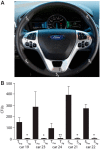Elucidation of bacteria found in car interiors and strategies to reduce the presence of potential pathogens
- PMID: 24564823
- PMCID: PMC3962071
- DOI: 10.1080/08927014.2013.873418
Elucidation of bacteria found in car interiors and strategies to reduce the presence of potential pathogens
Abstract
The human microbiome is influenced by a number of factors, including environmental exposure to microbes. Because many humans spend a large amount of time in built environments, it can be expected that the microbial ecology of these environments will influence the human microbiome. In an attempt to further understand the microbial ecology of built environments, the microbiota of car interiors was analyzed using culture dependent and culture independent methods. While it was found that the number and type of bacteria varied widely among the cars and sites tested, Staphylococcus and Propionibacterium were nearly always the dominant genera found at the locations sampled. Because Staphylococcus is of particular concern to human health, the characteristics of this genus found in car interiors were investigated. Staphylococcus epidermidis, S. aureus, and S. warnerii were the most prevalent staphylococcal species found, and 22.6% of S. aureus strains isolated from shared community vehicles were resistant to methicillin. The reduction in the prevalence of pathogenic bacteria in cars by using silver-based antimicrobial surface coatings was also evaluated. Coatings containing 5% silver ion additives were applied to steering wheels, placed in cars for five months and were found to eliminate the presence of culturable pathogenic bacteria recovered from these sites relative to controls. Together, these results provide new insight into the microbiota found in an important built environment, the automobile, and potential strategies for controlling the presence of human pathogens.
Figures




References
-
- Ara K, Hama M, Akiba S, Koike K, Okisaka K, Hagura T, Kamiya T, Tomita F. Foot odor due to microbial metabolism and its control. Can J Microbiol. 2013;52::357–364. - PubMed
-
- Begier EM, Frenette K, Barrett NL, Mshar P, Petit S, Boxrud DJ, Watkins-Colwell K, Wheeler S, Cebelinski EA, Glennen A, et al. A high-morbidity outbreak of methicillin-resistant Staphylococcus aureus among players on a college football team, facilitated by cosmetic body shaving and turf burns. Clin Infect Dis. 2004;39::1446–1453. - PubMed
-
- Bou G. linkspringercom. vol 391. Totowa, NJ: Humana Press; 2007. Minimum Inhibitory Concentration (MIC) analysis and susceptibility testing of MRSA. pp. 29–49. - PubMed
Publication types
MeSH terms
Substances
Grants and funding
LinkOut - more resources
Full Text Sources
Other Literature Sources
